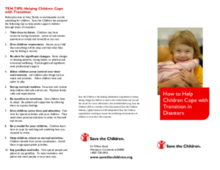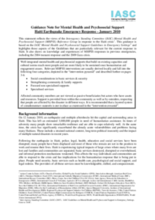Displaying 131 - 140 of 239
Practical information for agencies and advocates working with this Haitian children and families following the January 2010 earthquake, with special guidance on filing federal Temporary Protective Status applications.
Report looking at the milestones met and challenges ahead in responding to the needs of children and communities in earthquake affected Haiti. Includes reporting on child protection specific needs and the situation of children without parental care.
The Canary Islands were in the spotlight of international media attention in 2006 when more than 30,000 migrants arrived in rickety boats from West Africa. Among them were 928 children who arrived without a parent or care-giver.
A leaflet for parents on how to help your child cope during an evacuation or relocation in an emergency.
Guidelines for a multi-sectoral response to the most urgent mental health and psychosocial issues in emergency situations.
French translation of series of tools for rapid assessment of child protection needs in emergencies.
The Guidelines from the IAWG provide some of the strongest direction for ensuring emergency efforts protect family unity and avoid child-family separation. Where family unity can not be preserved, these guidelines instruct on tracing and family reunification, care arrangements, durable arrangements, special issues related to refugee children, and promotion of children’s rights.
Comprehensive update on the situation and responses underway following January’s Earthquake in Haiti. Reports on the full spectrum of the response including health, nutrition, education, early childhood development and the scale-up of protection mechanisms to prevent exploitation and abuse of children.
Provides guidance to organisations working in Haiti about how they can most appropriately communicate with communities, their own personnel and the media. The Guidance Note focuses mainly on the acute phase of the response (including early recovery) and provides basic guidance for action.
Key messages and guidance for action









